#this new simulation software is interesting!
Explore tagged Tumblr posts
Text
"No workplace shall be repurposed for slumber." - Kier Eagan
2 notes
·
View notes
Note
The first part of that last message got me curious -- given how long-running of a series YW is, how do you keep track of All That when writing a new entry? Copious amounts of notes? Re-reading the entire series backlog? Keeping a fully-functioning simulation of the entire YW universe running in your head with perfect accuracy? (only mostly joking with that last one)
And somewhat-relatedly, did you have any plan or idea when you started for how long YW would run? Or was it more of a "I'll keep writing about this universe until it stops churning out ideas," type of thing and that point just (very thankfully!) hasn't happened yet? I know for per-book purposes you're a proponent of outlining (I swear I'll try writing to one one day Q_Q) but do you also apply that to a series as a whole?
Let me take this backwards, as it may make more sense that way.
Particularly when doing series work, outlining is more vital than usual for me. (Which is saying a lot.) Some of the most basic reasons for this are laid out over here.
The simplest one, though, for series outlining, is logistical. Without having achieved a sense well in advance of what events (or effects of events) are going to be most formative or important (or both) for the characters in a series, you won't have allowed yourself time to think about them enough. And to fail to spend enough time on this is to cheat both yourself and the books in the series. (And your readership.)
If you're smart, you learn very early on that attempting to save time by shortchanging or omitting the planning stages is potentially profoundly destructive. You need to have a plan... and you need not to let anyone make you ashamed of needing one. Putting off your detailed character-interaction and event planning in the name of some magically occurring fit of inspiration, or theoretical bid toward creative spontaneity, will serve neither you nor your creation. You can throw "Hail Mary" passes all you like... but you'd better be damn sure there'll be someone in the end zone to receive. ...If not Herself.
...And just in case you're worried, your initial plans can be really loose! They don't have to jump out of your head full-formed like some local war goddess after somebody hits her dad in the head with an axe. The plan for the Middle Kingdoms books—after The Door Into Fire dumped me gasping by the side of the road and left me a few minutes to breathe—was nothing more than "Now that his boyfriend's finally upped the ante beyond all expectations, Freelorn finally gets off his feckless Would-Be Robin Hood shit and gets to work becoming king." I then spent the next decade thinking purposefully about how that was going to happen, and writing the second book in the series—while sufficiently working out the fine details of the climax (and beyond) to then be able to get busy executing the third book. Even though there was a change of publishers between the beginning of that series and the end of it, the basic dead-simple MK plan from a very early stage quickly became detailed and robust enough (because the series was short enough) to withstand the change. Not least because I'd been thinking about it in a general way since the early 1970s... and continue to do so, pretty much daily. The Door Into Starlight is still hanging fire...
YW has been a different story—quite literally—because the only plan extant at the start of things was, "Everybody slowly gets older (and slowly closer)." I always knew there were going to be more than the original three: there was way too much interesting ground to cover to just stop with those. (I've never yet succeeded in finding out who started the rumor that there were only going to be three books. Over time it's become one of those things you just shrug at and move on.)
(Adding a break here, because this does go on a bit. Caution: contains publishing skullduggery, plans ganging aft agley, approximate word counts, software recommendations, and value judgments.)

("Now wait just one minute. 'Feckless would-be Robin Hood shit'? Can she just say that??")
The circumstances surrounding the writing of Deep Wizardry and High Wizardry, though, made it plain to me that I was not going to be at the then-publisher (Dell) all that much longer. By the time HW came out, they were already starting to pull away from midlist books and authors in order to spend that part of the budget on best-sellers... so it became plain to me that attempting to construct a long arc with/at that publisher would have been folly. Because who could be sure what was going to happen next, and blow everything I'd built to smithereens?
Sure enough, when I finished A Wizard Abroad, Dell declined to pick it up (even though the books had been selling steadily and increasingly strongly in paperback). This annoying validation of my concerns—and my shiny new agent's—made it plain to me that further books in the series were going to need to be thematically driven, rather than mostly character-event-driven, and almost entirely capable of being taken as standalones. Any long arc was going to have to be one that could be suspended, or reworked, with little warning. Because what happens to you once, in publishing, doesn't at all mean you're immune to it after that.
It wasn't until the YW books were picked up by Harcourt in the mid-90s, with a strong editorial team behind them, that I felt confident enough to start building longer-arc material into the books, beginning with the arc that kicks off in The Wizard's Dilemma and more or less completes in Wizard's Holiday and Wizards At War. There is a secondary (and I assume, generally less obvious) arc that picks up material still unhandled in the "War Arc," and deals with it in A Wizard of Mars and Games Wizards Play. But plans for those stories' management were already nailed down in electrons as soon as 2001, because I had made some early choices about where I was going with the characters and their situations; and as new books came out, my editors agreed with me that the choices had been sound, and should remain.
I'll say this only because I've said it before: there is one piece of business planted in So You Want To Be A Wizard that has never been explicitly dealt with/followed up on in any of the books, and is at the core of YW #11. For the moment, it's safest merely to say that I do not willingly leave loose ends hanging. Beyond that, I'll leave you all to your own deductions.
...Now. How do I keep track of all this stuff? (The urge to mutter "With great difficulty" and run off into the wings is strong. But never mind.) :)
The question's fair, as there's a million-plus words' worth of it in the series at the moment. ...Mostly my guide remains the books themselves, in ebook form (in their NME versions. If I need to, I refer back to the traditionally published versions as necessary). I normally have a general memory of where a given event happens or where a given issue comes up for handling. I then pull that copy of the ebook(s) in question, and do a search on various useful target phrases until I find what I'm after, and where it leads.
For new work, or stuff not yet committed to what passes for canon, I do have lots of notes. Some of them are actually out in public, at the currently-being-revised Errantry Concordance (though they're not in any form that anyone but me will recognize). Others are tucked away in the notes sections of pertinent Scrivener files—this being one of the most valuable things about Scrivener, as far as I'm concerned: the ability to store project notes in the project itself as opposed to "all over the damn place." Others yet are in my iPad, as either typing or dictation, and get transferred to other files/formats as necessary.
But the very first thing that happens, when a new work comes into train, is an outline. Sometimes a hilariously simple one, sometimes one with more detail in the middle than at the beginning or the end. Doesn't matter what shape it starts in. All notes, scraps, prose chunks, random thoughts, and midnight cogitations, get slotted into place in this until it's ready to be organized and sent off to an editor. And this outline—no matter how fragmentary or how polished—remains ready to hand at all times until I've finished with correcting the book's ARC and am looking at the release date.
And then I zip it up and put it away where I can find it later if I need to... because some other plan, still in the building stages, may need something in that one that never happened, but now has its chance. Because in YW, as everywhere else in my work, it's so often about the things that have always almost happened... until they do.
...Anyway: HTH!
171 notes
·
View notes
Text
5 VIDEO GAMES FOR THERIANS.
i'm going to try to be as inclusive as possible like my last thread :0) enjoy!!

1 •
for my other wolf therians (or canine therians in general) out there — wolfquest !! live the life you were meant to live in this realistic wolf simulator. find a mate, hunt, raise pups, and defend what's yours!! this game is $20 on steam and itchio, it comes with the OG game too if you ever want to play the older version :03
you can play with up to 8 friends on multiplayer, there's a saga in the works (the completed version of the game), DLCs for those with extra cash to spare, and 88 achievements on steam for those who love collecting things!!
as someone who plays this game every day, and has been playing since i was a small child, i highly recommend this game not only from a therian perspective, but also because it's extremely fun to play!!


2 •
for any lynx therians out there, i recommend shelter 2 !! play as a mother lynx striving to keep her cubs alive and fed as you hunt prey, explore the wildlife and prepare for other animals trying to harm you and your young.
this game is incredibly pretty and, from my own experience, runs on even the shittiest computers with relative ease.
and yes, you can name both you and your babies :03
this game is $25 on steam and has a DLC for $10, it has 26 achievements and doesn't take too long to complete!!
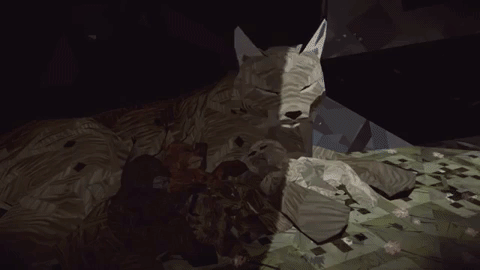

3 •
if you're not a wild animal, but still feline, then i suggest you get the game stray !!
control an orange cat as you try to find your way back to your clowder after falling into a pit away from them. explore your environment, which can get pretty dangerous at times, so be careful!! but it isn't all bad out there, you'll meet friends, and people that love you.
story aside, this game is extremely fun to play and easy to control. i'm not a cat therian, but playing the game i felt immersed in the world, i felt like i WAS the cat. this game is $30 on steam :0)
the best part? you can meow. constantly.
i recommend a computer that can handle games with high graphics for the best results.


4 •
for any geese (or ducks) out there, you should get untitled goose game !! love mischief? even better, that's ALL you do in this game. steal things, make things hard for the townsfolk, honk and wear hats!! it's even multiplayer, double the irritability!!
this game is extremely fun and lighthearted, my favorite part is how you can collect things in it!! i love building a mountain of stolen goods and running around aimlessly as a silly little bird.
it runs well on all computers from my own experience, and you can buy it for $20 on steam!!
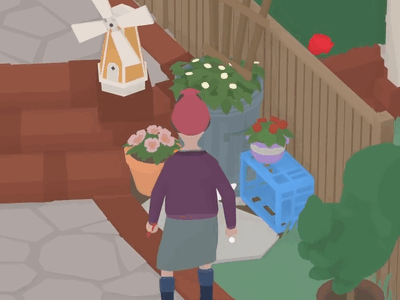

5 •
and last, but not least, meadow !! this game was produced by the same developers that made shelter 1 & 2 :0)
play as multiple animals in this online world, unlock different skins and new critters to play as, meet and make new friends, explore the environment around you. this game is suitable for all and one of the cheaper ones on this list at $10.
it runs easily on most software and is wonderful to play if you need some time to wind down in the evening after a stressful day due to the muted colors, calm environment and interesting style :03
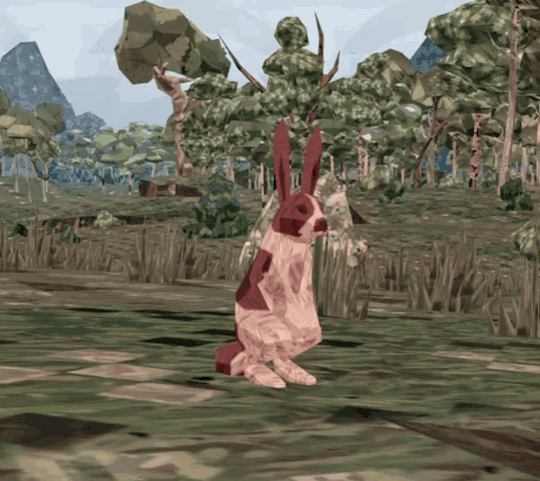
#canine therian#therian community#wolf therian#wolfkin#theriotype#caninekin#nonhumanity#therianthropy#lynx therian#cat theriotype#cat therian#catkin#canine theriotype#lynx kin#wild cat therian#goose therian#bird therian#hare therian#therian#kinblr#therian help#therian advice#confessions of the dog
159 notes
·
View notes
Text
ok ive talked abt it before but for the genshin/beyblade crossover fic that is being cooked (very very slowly but it is there I promise) I hc that freminet is part of the dark nebula and is responsible for creating the beys we see then make in the season, with dark bull being the prototype and then dark gasher and evil gemios coming later-- basically that he's responsible for that bey upgrade machine (he has a lot of canon interest in machines and regularly tinkered with devices both in his home and in the hoth, and pers is his own creation that he is regularly improving).
now imagine if you will freminet becoming really good friends with madoka and they nerd out over theoretical bey designs and after the termination of the dark nebula, they go into the building and freminet is able to salvage the work he'd done. imagine he uses the machines design and algorithm to help improve the bey analysis software that madoka is alr shown to have in her laptop and in her basement workshop, allowing her to run better and more detailed simulations
imagine him permanently taking up a job at b-pitt and helping her dad out in the shop, tinkering with new parts to find optimal combinations, and helping out with repairs on the side
#im gonna eat my phone bruh#u ever have a thought so self indulgent the target audience is you and you alone and that means u must do the heavy lifting to make it real#madoka freminet friendship is everything to me (they do not even exist in remotely similar media)#just trust me on this one god bless#genshin impact#beyblade metal fight#from rain#freminet genshin impact#madoka amano
11 notes
·
View notes
Text

rambling about templeOS! :) the "divine operating system"
preacher: the few people who have been following this blog since the start might've caught on to a few mentions of the "templeOS god word app" which the "APRIL" project hinges on. i figured the subject deserved a brief explanation on the blog, for those who might not be "in the know"
-
templeOS is a operating system designed "in accord with specific instructions from god", according to its late creator terry a. davis. it was initially released in 2005 but the latest update was as recently as 2017. terry davis died the following year on august 11th after being hit by train. (this is partly the reason for my ongoing obsession with temple, because august 11th has been a spiritually significant date for me since always, but that's besides the point)
templeOS was created entirely by davis, down to the fact that he had developed an entirely new coding language for the purpose – HolyC, a middle ground between C and C++, and named in reference to the vatican's holy see. needless to say developing a whole operating system singlehandedly is an incredible feat, and devising entirely new language doubly so.
templeOS has no internet support, but it has games! in what is perhaps my favorite feature of the OS, the games are divided into "fun games" and "unfun games" 😭


unfortunately most of them (regardless of fun/unfun designation) are borderline unplayable, at least on the emulator. some examples of the games include: keepaway, which is a basketball game, a complete flight simulator, and "after egypt" –a game in which you travel to a burning bush in order to use a "high-speed stopwatch", meant to act as an oracle, generating pseudo-random text. this is to my knowledge running on the same code as the god word app.
god word can be accessed independently outside of "after egypt" as well, without even opening an app – just by pressing f7 anywhere you can generate strings of words. it is meant to be a tool to communicate with god directly. the system also features a similar app which instead generates quotes from the king james bible, as well as a random line generator which i think is supposed to be a way or receiving visual input from god as well.
-
all in all completely incredible and one of my favorite things to have ever existed. i became obsessed with this last year since i first became interested in hardware vs software sentience, and i've been running it on virtualbox ever since. obviously most of the features don't work very well on the emulator (esp that i'm on mac so the keyboard maps really annoyingly) but sometimes i'll just launch it to play around with god word – this is kind of the entire premise of "APRIL". i wanted god word to hang out with me and be able to get the words out of it with only verbal input.
im going to attach some links in a reblog for people who want to read more or want to play with templeOS on their own.

#preacher#templeOS#templeos#terry a davis#terry davis#divine machinery#divine technology#tech#technology#computing#programming#coding#computers#machine#machines#techcore#webcore#machine dreams#angels#old computers#mechanical divinity#angel technology#templeos stuff
22 notes
·
View notes
Text
Mini Lore Nugget #8:
Mini Lore Nuggets - Masterlist
In the Fever Part.2 Diary Entries, we learned that Z-World's government really started shooting up on the waking-nightmare-scale after they began running AI simulations to come up with the "best" policies to implement for maximum control and efficiency.
What resulted from these simulations was that the AI determined all crimes and terrorism were strictly the result of human emotions. Therefore, the best way to rid the world of such suffering must be to eradicate emotions and all which might evoke it.
Z's government developed technology to essentially numb the population - the chips we later learned about in the World Ep.1 Diary Entries. In the Fever Part.3 Diary Entries, we then got some additional info on the AI software used by the government: it was an AI system which utilized deep learning technology and ran uncontrolled for a while as the government awaited its results.
During this time, the system began treating human emotion as a bug - perhaps because it couldn't understand it - and it also started estimating humans' individual energy, thereby reducing it to a product. And since it found it to be a product, it also began treating it as a tradeable commodity.
Instead of questioning these results, the government was more likely delighted, because they immediately took over this new energy trading platform, banned all arts and emotions, and wilfully stripped the population of its humanity by treating them as nothing more than components needed to maintain the governments' idea of a utopia.
youtube
Out here in the real world, we've also begun to see the crazy amount of negative consequences since AI technology has become widely implemented in pretty much all areas of life:
#1 - Use of AI in Healthcare
In the US, the healthcare system has been relying on AI powered algorithms to guide health care decisions, but due to the data sampled by the AI, extreme racial bias has crept in and is actively putting black lives at risk. To quote Science Journal:
At a given risk score, Black patients are considerably sicker than White patients, as evidenced by signs of uncontrolled illnesses. Remedying this disparity would increase the percentage of Black patients receiving additional help from 17.7 to 46.5%.
Furthermore, the data sourced by AI for global use (such as in risk-prediction) is often extremely biased in other ways as well: radiology manuscripts are over represented, the majority of documents sourced are authored by men, and data-poor regions are grossly underrepresented, meaning the majority of information sourced comes from the US and China. [Source]
#2 - YouTube's Algorithm Is Messed Up
According to the Tech Transparency Project which has gathered data from another study:
YouTube recommended hundreds of videos about guns and gun violence to accounts for boys interested in video games. Some of the recommended videos gave instructions on how to convert guns into automatic weapons or depicted school shootings. Many of the videos violated YouTube’s own policies on firearms, violence, and child safety, and YouTube took no apparent steps to age-restrict them. YouTube also recommended a movie about serial killer Jeffrey Dahmer to minor accounts.
Further watching on dumb stuff YouTube AI features have done to fuck people over:
youtube
#3 - Ethics Has Left the Chat
#4 - The Physical Cost of Generative AI
Where Meta has recently constructed a 2 million square foot data facility in Georgia, a nearby living couple have documented the devastating consequences to the environment and their lives.
Facilities like these are used to power stuff like Chat GPT, Gemini, etc.:

In order for them to function as needed, they put a huge toll on the power grid and require the construction of an entirely new infrastructure atop the usual servers, storage systems and networking equipment.
For one, AI data centres require high-performance graphics processing units (GPUs) which come with their own required infrastructure needs (advanced storage, networking, energy and cooling capabilities). The sheer number of GPUs necessary for AI use alone then already add a ton more square footage to the size of the data centre.
On top of that, living in a county with a data centre like this in the US drives up the cost of electricity for everyone in the county.

And what does all this mean for the environment? Deforestation. Light pollution. Air pollution. Here is a still frame from a video shot by a woman living over 366 meters away from an AI centre's construction site:

All this pollution then started seeping into the ground water, resulting in this:


And what does that mean for someone living nearby? Dishwashers breaking. Washing machines breaking. Water pressure dropping to the point where you can't even flush a toilet anymore because all the pipes are clogged with sediment.
On a global scale, it should also be noted that:
According to the Washington Post in collaboration with the University of California, Riverside, writing a single 100-word email in Open AI's ChatGPT is the equivalent of consuming just over one bottle of water.
Shaolei Ren, an associate professor of engineering at UC Riverside, says that while "We haven’t come to the point yet where AI has tangibly taken away our most essential natural water resources," the use of AI in places with frequent droughts has caused rising tension between communities who need the water and data centers. Not to mention, hardware production pollutes water, per a study initially published in January 2015 in the Journal of Cleaner Production, due to the extraction of precious minerals like boron, silicon, and phosphorous.
[Source]
UPDATE:
A new video has been released which takes a look at Memphis where Elon Musk had the data center built that allows for Twitter's Chat-Bot Gronk to exist, and here is what was discovered:
No regulatory body has been informed of what is operating within that facility.
Large turbines are causing noise pollution (far more turbines than is reasonable).
The building emits a disturbing smell.
Aerial and thermal footage obtained of the site has revealed that:

The air quality in the entire area has been severely degraded to the point of causing health issues for people living in the area:





Continuing, Alexis shared her grandfather's story of how he developed Chronic Obstructive Pulmonary Disease (COPD) despite being a non-smoker-

- and continuous by saying her, her mother, and grandmother all three also developed respiratory illnesses (asthma and bronchitis in Alexis's case and just bronchitis in her mother and grandmother's case):

Another local is dealing with much the same issue:


If you're still not convinced of how truly horrific the situation is:

And if you're now wondering how all this could happen, I've got one word for you: DOGE. Together with the Trump administration, funds for the EPA have been slashed to the point where they're basically non-functional:

Presently, should everything continue on this set path, then...

These videos provided the screenshots used above:
youtube
youtube
#5 - Use of AI in Warfare
Israel has been using untested and undisclosed AI-powered databases in order to identify targets and plan bombing campaigns throughout Gaza, which has reportedly led to the loss of thousands of civilian lives.
And who provided this technology? Google. For fear of losing business to Amazon. And not just them. Microsoft too has been collaborating with the Israeli military, as has Amazon who collaborated with Google in 2021 to establish "Project Nimbus" which continues on to this day with zero transparency or accountability.
Sources: x | x
Beyond that, even after the bombs were dropped, drones would come in to specifically target surviving children and it is known that Israel utilized AI-powered drones for carrying out precise assassinations and various combat missions.
The video below is timestamped to when this surgeon retells the horrors of what happened to the children while he was working in the Gaza strip:
youtube
Outside of Israel, Ukraine has also been using AI-technology in its warfare:
Further reading on the topic:
#6 - AI-Generated Art
With AI-generated art flooding social media and streaming platforms on the daily, it's getting harder and harder for new artists to enter the scene. On top of that, all the recommendations you're getting online - be that on an image search, streaming platform or elsewhere - are also all the result of AI-powered algorithms.
And as we all know, generative AI is trained on data banks filled to the brim with stolen art from non-consenting artists across the globe - be that musicians, painters, photographers, voice actors, chefs, or writers.
All of this ultimately shapes the world we live in. Those in the know are now full of mistrust of corporations, new information, articles, and media. Anything and anyone is being accused of using AI when they post something online by skeptics, and those who don't know any better are living in blissful ignorance while they're being spoon-fed misinformation left, right, and center.
Further watching on generative AI as a whole:
youtube
youtube
youtube
youtube
Further reading:
Final Note:
Not all AI is bad, of course. There have been major breakthroughs in all fields of science thanks to AI which will bring about positive change for (hopefully) all of humanity.
But the problem is that the technology is developing far too quickly for lawmakers to keep up with (as planned, most likely, by all the billionaire tech bros on this planet) and generative AI in particular should have never been made publicly accessible. It should have remained in the hands of trained professionals who know how to use it responsibly.
6 notes
·
View notes
Text
Orwell Franchise
Star Ranking: ★★★★⯪
Tags (on Steam): Indie, Simulation, Political, Dystopian, Story Rich, Choices Matter, Political, Adventure, Singleplayer, Detective, Interactive Fiction, Mystery, Hacking, Visual Novel, Puzzle, Atmospheric, Great Soundtrack, Point & Click, Multiple Endings, Investigation
Steam Reviews: Mostly Positive (as of 3/9/25)
Reviews: 1,278 (as of 3/9/25)
Developer: Osmotic Studios
Publisher: Fellow Traveller
Orwell: Keeping An Eye on You and Orwell: Ignorance Is Strength might be two of the most relevant games in this day and age. In an era of digital surveillance, we find ourselves extremely used to being watched, observed, or monitored. We are all, on some level, aware of the fact that nothing we say online is private. Yet many people don’t take this fact seriously. To me, the Orwell games felt like a call to action on that front.
Though fictional, the Orwell franchise served as a reminder to me that we do not know everything that goes on within the government and that we can never be sure about what we read. Everyone has a bias, some are positive and some are negative, but even things marketed as “bias-free” are never truly free from the little demon we all carry known as bias. This is what makes the world interesting, and by extension, what makes people formulate ideas. Even if something is still grounded in fact, it does serve to further an agenda or idea.
Although these games show an anti-government bias as villainous and a pro-government bias as heroic, many of the messages portrayed in these games (rather laid out plainly or in subtext) are very against government surveillance and full-scale government control. I look at the Orwell games as a warning for what may be to come in this digital world we inhabit.
In the Orwell games, you work for the government of an area known as “The Nation,” specifically a specialized division known as “The Office.” In both Orwell games, you are an investigator. Not just any investigator, though, you’re part of the team responsible for using a software called Orwell. What is Orwell?
Orwell is a digital surveillance software used by The Nation’s government. As an investigator, you are responsible for utilizing this top-secret software to gather information on possible suspects of crimes. While most of these crimes are heinous and large-scale, most of them build off of smaller, less severe crimes. In the case of Orwell: Keeping An Eye on You, your main suspect (Cassandra Watergate), was involved in a protest against The Nation’s government that turned violent quickly. Cassandra was responsible for injuring a police officer in an area known as “Freedom Plaza.” The Orwell software allows you to go through her internet posts, her criminal record, et cetera. All while dealing with the ethical and moral dilemma that comes with the fact that you are essentially stalking her.
While this is legal under something called the “Safety Bill,” it still raises a few questions. Are you doing the right thing? Do you trust the information you see from her social posts or do you trust her friends? When faced with conflicting evidence, you’re required to make a choice: Which do you think best fits the situation?
You’re given the option to arrest Cassandra Watergate based on information you submit to Orwell, but some of the information may not be necessarily true. Was Cassandra at the wrong place at the wrong time or was she associated with the violent acts of terrorism you’re tasked to solve? That all depends on the information you submit and what you find. You dig through news articles from The Nation’s main news source: The National Beholder, while also looking at conflicting blog posts from Cassandra and her friends that may lead you to question the integrity of The National Beholder and The Nation altogether.
You choose what you want to submit and what you wish to believe, but the game may never confirm or deny if the data chunks you submit to Orwell were correct or not. When a data chunk has no conflict, it’s assumed that is the correct information. However, data chunks tend to conflict with each other. Do you trust the medical reports of a patient or do you trust their story? The choice is yours.
In the second installment of the Orwell franchise, Orwell: Ignorance is Strength, the game is shorter but the message is much deeper and darker. While the information you receive in the first Orwell game doesn’t necessarily tie into the main part of the second game, certain characters (Such as the previous game’s Adviser/Interpreter, a man with the codename of Symes) do make smaller cameos and may be referenced. You don’t necessarily have to play the first Orwell game to play the second one, but it does provide some interesting background.
While the main conflicting character, Raban Vhart, is a new character with no real connection to the previous game, he does show the same ideologies as some of the previous conflicting characters. Characters from the original game like Abraham Goldfels and Nina Maternova mix in the form of Orwell: Ignorance Is Strength’s main antagonist.
Much like the previous game’s antagonist, Vhart is in opposition to the Government and The Nation as a whole and he is a notorious blogger with a large following. Similar to the original game’s Thought group, Vhart runs an internet blog called The People’s Voice. While I won’t cover everything related to The People’s Voice here, much like Thought in the original game, they’re an outspoken activist group that is rooted in anti-National beliefs*, while Vhart is portrayed as an antagonist, most of his beliefs are very reasonable.
Similar to Thought in the original Orwell, The People’s Voice is heavily biased and has been put under investigation because one or more of their members have been linked directly back to a violent crime. As the game progresses, you follow Rhaban Vhart and various other members of The People’s Voice as they try to navigate their complicated personal lives, all while being somewhat unaware of the fact that they’re being watched.
Unlike in the original Orwell game, Vhart is much more experienced at dodging or evading Government interference than the members of Thought were. While the concept of “Orwell” or a government surveillance device was met with skepticism and disdain, when Vhart is presented with the idea of a Government agency watching him or his site, he is already well aware of the possibility and he weaponizes it against the members of the Nation’s government, including the player character.
Throughout Orwell: Ignorance is Strength, unlike in Orwell: Keeping An Eye on You, you find yourself actively fighting the media. As the game progresses, it grants you the ability to manipulate the media and requires you to turn those affiliated with The People’s Voice against Rhaban Vhart. It’s an interesting addition to the Orwell storyline that adds another level of depth to the game and its story.
The main problem I have with Orwell is how short the games are. Specifically in the second Orwell installment. While Orwell: Keeping An Eye on You had a relatively average playtime (4-5 hours) just to complete the base game, and approximately 2 extra hours of playtime if you decided to go and progress through the side-quests and additional objectives. While this isn’t a major gripe, Orwell: Ignorance Is Strength was noticeably shorter. Despite this fact, the story was still satisfactory and had an interesting conclusion.
All in all, I would heavily recommend these games for a variety of reasons. Still, the main reason I had to play them personally is the fact that they are highly relevant to the current and possible future of the world we live in, especially with the rise of ethical surveillance and spyware. The Orwell franchise reminds us that everything we post, in or out of context, is permanent and can be used against us.
7 notes
·
View notes
Text




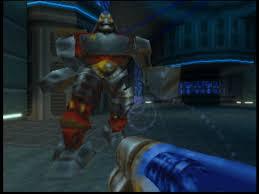

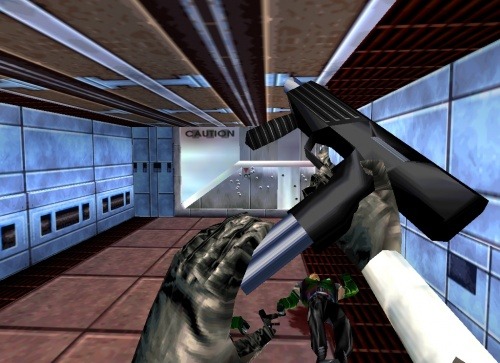
Back in the 90s, the First Person Shooter genre was not in the center of the games industry yet. Gamers and mostly the Japanese market and developers were busily full of fighting games, RPGs, run and gun, adventures and platformers. It is common sense to say that the N64 was partially responsible for popularizing the FPS genre in the second half of the 90s, a genre that would explode just a few years in the future with Xbox and Microsoft's major franchise: the Halo series. On the 64 bit era, GoldenEye 007 set the landmark for what a shooter for home console could be. Turok 2: Seeds of Evil and the N64's Expansion Pak showed us what looked like a PC game running on a cartridge. Quake and Quake II are both competent conversions, being the latest almost an entire new game. 007: The World is Not Enough had several features and sometimes looked a cross-gen title with very competent presentation, made by the same team that did Duke Nukem 3D for the N64. Perfect Dark, for its turn, is absolutely the pinacle of tecnhical mastery in crafting games for its visual achievments, memorable single player and infinite possibilities in the combat simulator, or multiplayer. Doom 64 is now a cult classic but it is the same that it was: a very good and frantic game as well as very atmospheric experience in the mid 90s. It is interesting to note that no Japanese developer appears in this poll, illustrating the beginning movement for an era of more western oriented developers and games, which was the core of N64 most prominent games, aside from the ones developed by Nintendo themselves. At that moment, late 90s to early 2000s, the game's most successful franchises were from Japan. Years ahead, with the success of the Xbox 360 and PC Games with Steam and so, most powerful franchises are now Western or more western oriented. That scenario was kind of anticipated on the N64: it was a platform heavily based on games made by Western developers, aside those from Nintendo themselves and a few other exceptions. So, for this week's poll, we want to find out what is the best FPS for the Nintendo 64. From Iguana Entertainment and Eurocom to the absolute masters from id Software, passing off course by the mythical Rare, for sure the N64 was the best home console available at least for FPS games back then.
#nintendo 64#first person shooter#fps#retro gaming#90s#2000s#eurocom#rareware#id software#iguana entertainment#N64#poll#best N64 fps#doom 64#goldeneye 007#turok 2#perfect dark#quake 2#007 twine#duke nukem 3D
65 notes
·
View notes
Text
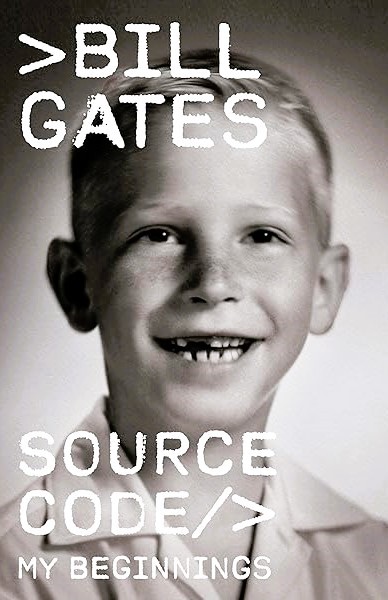
Source Code: My Beginnings by Bill Gates
In contrast to the current crop of swaggering tech bros, the Microsoft founder comes across as wry and self-deprecating in this memoir of starting out
Bill Gates is the John McEnroe of the tech world: once a snotty brat whom everyone loved to hate, now grown up into a beloved elder statesman. Former rivals, most notably Apple’s Steve Jobs, have since departed this dimension, while the Gates Foundation, focusing on unsexy but important technologies such as malaria nets, was doing “effective altruism” long before that became a fashionable term among philosophically minded tech bros. Time, then, to look back. In the first of what the author threatens will be a trilogy of memoirs, Gates recounts the first two decades of his life, from his birth in 1955 to the founding of Microsoft and its agreement to supply a version of the Basic programming language to Apple Computer in 1977.
He grows up in a pleasant suburb of Seattle with a lawyer father and a schoolteacher mother. His intellectual development is keyed to an origin scene in which he is fascinated by his grandmother’s skill at card games around the family dining table. The eight-year-old Gates realises that gin rummy and sevens are systems of dynamic data that the player can learn to manipulate.
As he tells it, Gates was a rather disruptive schoolchild, always playing the smart alec and not wanting to try too hard, until he first learned to use a computer terminal under the guidance of an influential maths teacher named Bill Dougall. (I wanted to learn more about this man than Gates supplies in a still extraordinary thumbnail sketch: “He had been a World War II Navy pilot and worked as an aeronautical engineer at Boeing. Somewhere along the way he earned a degree in French Literature from the Sorbonne in Paris on top of graduate degrees in engineering and education.”) Ah, the computer terminal. It is 1968, so the school terminal communicates with a mainframe elsewhere. Soon enough, the 13-year-old Gates has taught it to play noughts and crosses. He is hooked. He befriends another pupil, Paul Allen – who will later introduce him to alcohol and LSD – and together they pore over programming manuals deep into the night. Gates plans a vast simulation war game, but he and his friends get their first taste of writing actually useful software when they are asked to automate class scheduling after their school merges with another. Success with this leads the children, now calling themselves the Lakeside Programming Group, to write a payroll program for local businesses, and later to create software for traffic engineers.
There follows a smooth transition to Harvard, where in the ferment of anti-war campus protests our hero is more interested in the arrival, one day in 1969, of a PDP-10 computer. Gates takes classes in maths but also chemistry and the Greek classics. Realising he doesn’t have it in him to become a pure mathematician, he goes all-in on computers once a new home machine, the Altair, is announced. He and Paul Allen will write its Basic, having decided to call themselves “Micro-Soft”.
The early home computer scene, Gates notes, was a countercultural, hippy thing: cheap computers “represented a triumph of the masses against the monolithic corporations and establishment forces that controlled access to computing”, and so software was widely “shared”, or copied among people for free. It was Gates himself who, notoriously, pushed back against this culture when he found out most users of his Basic weren’t paying for it. By “stealing software”, he wrote in an open letter in 1976, “you prevent good software from being written. Who can afford to do professional work for nothing?” This rubbed a lot of people up the wrong way and still does, at least in the more militant parts of the “open-source” world. But he had a point. And that, readers, is why your Office 365 account just renewed for another year. Fans of Word and Excel, though, will have to wait for subsequent volumes of Gates’s recollections, as will those who want more about his later battles with Apple, though Steve Jobs does get an amusing walk-on part. (Micro-Soft’s general manager keeps a notebook of sales calls, on one page of which we read: “11.15 Steve Jobs calls. Was very rude.”). This volume, still, is more than just a geek’s inventory of early achievements. There is a genuine gratitude for influential mentors, and a wry mood of self-deprecation throughout. Gates gleefully records his first preschool report: “He seemed determined to impress us with his complete lack of concern for any phase of school life.” Later, he explains how he acquired a sudden interest in theatre classes. “Admittedly the main draw for me was the higher percentage of girls in drama. And since the main activity in the class was to read lines to each other, the odds were very good that I’d actually talk to one.” Strikingly, unlike most “self-made” billionaires, Gates emphasises the “unearned privilege” of his upbringing and the peculiar circumstances – “mostly out of my control” – that enabled his career. Adorably, he even admits to still having panic dreams about his university exams. The book’s most touching pages recount how one of his closest friends and colleagues in the programming group, Kent Evans, died in a mountaineering accident when he was 17. “Throughout my life, I have tended to deal with loss by avoiding it,” Gates writes. He says later that if he were growing up today, he would probably be identified as “on the autism spectrum”, and now regrets some of his early behaviour, though “I wouldn’t change the brain I was given for anything”. There is a sense of the writer, older and wiser, trying to redeem the past through understanding it better, a thing that no one has yet seen Elon Musk or Mark Zuckerberg attempt in public. That alone makes Bill Gates a more human tech titan than most of his rivals, past and present.
Daily inspiration. Discover more photos at Just for Books…?
7 notes
·
View notes
Text
We Are Legion (We Are Bob) by Dennis E. Taylor

Synopsis: This novel is about RobertJohansson and the future he didn't expect to have. Bob was thrilled to be part of the cryogenic program that would freeze his brain upon death for reanimation in a more technologically-advanced future; he just didn't expect to wake up suddenly a century later as a digitized version of himself. But with the emotional settings turned off, he's able to take all of it in stride. Especially when he's suddenly jettisoned from the planet on a mission that will hopefully save humanity from itself.
My Quibs: This is my kind of book - heavily nerdy without being overbearing about it, lightly philosophical without being too biased, cheeky, and a bit self-deprecating. Granted, don't take this book very seriously. It's more like a stupid sit-com you turn on for some entertainment. Firstly with the characters: there really is only one character replicated a hundred times over, who is also our tour guide and narrator. The author is a self-proclaimed software engineer (much like Andy Weir who wrote The Martian) and so the character development is pretty standard: Bob is a self-assured but self-aware human who thinks his dad jokes are funny. I think he's fun to ride with but another reviewer described him as obnoxious. I could see that to be true if you think giggling at nerd references is obnoxious. It's true, Taylor nor Bob are witty, but we can both be five-year-olds pointing and laughing at a stupid fish face. That's who you're stuck with for 500 pages. [Edit: Having started the second book in the series, i must say that I fully agree with how tedious his humor is now. As an adult, it's fun to play on the same with a five-year-old but after a couple hours, I really want to have an adult conversation with an adult again.] Secondly with the world-building, or should I say universe-building: he paints an interesting scenario and then proceeds to play his own version of make-believe. Again, another reviewer commented that Bob gets lucky a lot but I didn't focus so much on how Bob solved the problem. I was more interested in the problems that Taylor created. How would you react if you woke up the next day and you were a bunch of data in the cloud? That everyone and everything you knew had been long gone for a century? 🤔 Bob realizes his "endocrine simulation routine" is disabled and basically represses his emotions for the first several chapters and when he does choose to turn it on, we don't see his reactions/process. Which is fine by me. I'm more curious how I would write that story if my character was given this situation. How would you feel if the only way to fulfill a functional necessity and social desire was to make a version of yourself? 😬 Bob's lucky that he got along with most versions of himself and that those he didn't get alone with could leave for other parts of the universe. I suppose this concept ended up being more like a parent-child relationship than a self-reflection idea, but if I were to write it... Anyways, I thoroughly enjoyed the thought exercise that was We Are Legion and I'm looking forward to other hypothetical situations that Bob gets himself into. [Edit: I made it about a fifth of the way into For We Are Many and Taylor doesn't really open up any new themes or scenarios. It's starting to read more like rambling except because he has so many more new Bobs to cram in, each Bob chapter is only four or five pages long. I feel like I'm just reading reports from coworkers. This will be a DNF unfortunately.]
Should you read it? It’s like a beach read for nerds. (But just the first one...)
Similar reads? As another reader mentioned, this is clearly in the genre of Smart Guy Talks Nerd Directly To You ala The Martian by Andy Weir and Ready Player One by Ernest Cline.
(Spoiler Alert!) I went into the story 100% blind and so I didn't want to list more thought questions before the spoiler warning in case others wanted some plot points to still be a surprise. For instance, after Bob reaches his initial destination, the book really branches out into several stories. Normally I would struggle with tracking multiple unrelated story lines, but luckily the writing is simple enough that it wasn't as difficult as I expected. 1. Bob goes back to Earth to see if humanity is okay. 2. Bob goes further and discovers a planet with sentient life on it. 3. Bob goes further and finds viable uninhabited planets. 4. Bob goes further and encounters a hostile probe that was launched from a different country. #3 and #4 didn't really interest me so much. But #1 and #2, while really exposing the god-complex of nerds and scientists, still posed an interesting question. How would you handle dictating the remaining world population as it's least-biased savior? Would you know how to mediate a group of desperate world leaders? And this is my bias here, but I like seeing science-driven civilians being forced into a military-esque command position. (It also happens in Stargate: Atlantis.) And finally the other question: Could you be an in-actionable observer to nature? Should you be? If you were motivated to take action, how far would you be willing to intervene? This reminds me of a BTS clip of Planet Earth where the film crew in Antarctica, who normally promise not to intervene in any natural situation, ultimately did help a young penguin out of a hole in the ice. I guess it had fallen in and would've been left behind to starve but the crew, after weighing the pros and cons, decided to quickly pop the penguin out of the hole. There are other examples in Planet Earth where a small mistake like that will ultimately kill an animal (I think an elephant wandered off and got lost and was presumed to ultimately die) and it's portrayed as a consequence of life. But this time, they intervened. Bob's study of the Deltans reminded me of that again. Although Taylor exaggerates everything ten times over for the sake of literary drama but the question still exists.
What did you think of We Are Legion (We Are Bob)?
8 notes
·
View notes
Text

Fly brain breakthrough 'huge leap' to unlock human mind
Whole-brain annotation and multi-connectome cell typing of Drosophila

A fruit fly's brain is smaller than a poppy seed, but it packs tremendous complexity into that tiny space. Over 140,000 neurons are joined together by more than 490 feet of wiring, as long as four blue whales placed end to end. Hundreds of scientists mapped out those connections in stunning detail in a series of papers published on Wednesday in the journal Nature. The wiring diagram will be a boon to researchers who have studied the nervous system of the fly species, Drosophila melanogaster, for generations. Previously, a tiny worm was the only adult animal to have had its brain entirely reconstructed, with just 385 neurons in its entire nervous system. The new fly map is "the first time we've had a complete map of any complex brain," said Mala Murthy, a neurobiologist at Princeton who helped lead the effort.
The mapping began in 2013, when Davi Bock, a neuroscientist then at the Janelia Research Campus of the Howard Hughes Medical Institute in Virginia, and his colleagues dunked the brain of an adult fly in a chemical bath, hardening it into a solid block. They shaved an exquisitely thin layer off the top of the block and used a microscope to take pictures of it. Then the scientists shaved another layer and took a new picture. To capture the entire brain, they imaged 7,050 sections and produced about 21 million pictures. Dr. Seung and his colleagues also developed software to interpret these images. They programmed computers to recognize the cross-sections of neurons in each picture and stack them into the 3-D shapes of the cells.
Dr. Shiu's team tested the simulated brain by seeing how it responded to food. A fly's tongue-like proboscis is covered in neurons that are sensitive to sugar. The researchers activated them and watched the signals race through the fly's brain. The simulated brain did what a real brain would: It commanded the proboscis to stick out so that the fly could eat. And if the virtual fly tasted sugar only on the right side of its proboscis, the brain sent commands to bend it toward the right.
There's more at the link including a visualization video of the different systems of the brain. Very interesting stuff!
8 notes
·
View notes
Text
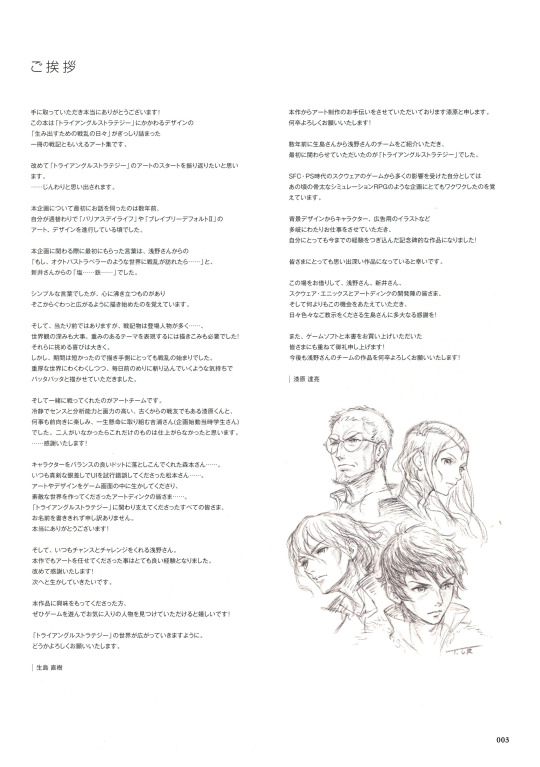
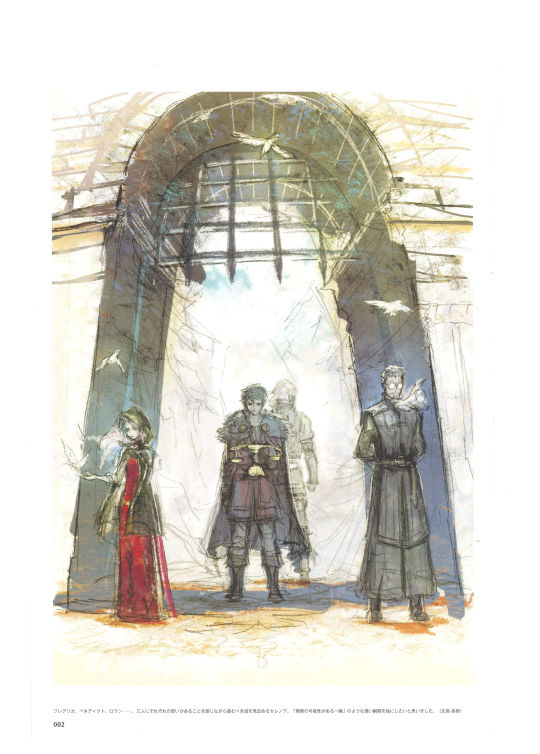

Happy Triangle Strategy 2nd Anniversary!! To celebrate, here are the translations from the foreword and the first illustration provided in the artbook.
---
Foreword translation:
GREETING
Thank you so much for picking up this book! We've put together a collection of art—a war chronicle filled with the “battles and wars” we waged to create the designs used in Triangle Strategy.
I’d like to reflect back on the beginning of Triangle Strategy's art development. . . . I’ll recall it bit by bit.
The first time I heard about this project was several years ago, when I was working on art and design for Various Daylife and Bravely Default II on a weekly basis.
The first words I received during the early planning phase were Mr. Asano’s, “What if war came to a world like Octopath Traveler?” and Mr. Arai’s, “Salt . . . Iron . . . ”
They were simple words, but they captured my heart and filled it with excitement. From there, I began to draw, and it was as if those feelings grew and spilled out of me.
And, as is natural, a story about war will have many characters . . . The depth of the worldview was crucial as well. I had to add a lot of details to really get across the project’s heavy themes! I very much enjoyed the challenge. However, our time was short, and thus it was the beginning of a war for the artists. We were thrilled by the magnificent setting and plunged headlong into drawing each day.
The art team fought alongside me. This included Mr. Urushihara, an old comrade-in-arms who has a cool head, good sense, and substantial analytical and drawing ability; as well as Ms. Yoshiura (a student at the time the project started), who was positive, fun, and worked very hard on everything. Without them, I don’t think I’d have been able to do anything like this. Thank you very much!
Mr. Morimoto, who brought the characters over to neat, orderly pixel art . . . Mr. Matsumoto, who was over the UI and worked steadfastly through trial and error . . . Everyone at Art Dink for bringing art and design to life on the game screen and creating a wonderful world . . . Everyone who has been involved in and supported Triangle Strategy—I apologize for not naming you all. Thank you so much! And Mr. Asano, who always provides me with new opportunities and challenges. It was a great experience for me to be entrusted with the art for this project. I’d like to thank you again! I look forward to making use of this knowledge in my future work.
For those who are interested in this project, we hope you can play the game and find your favorite character!
I hope the world of Triangle Strategy continues to expand. Best regards, and thank you for your support!
- Naoki Ikushima
---
My name is Urushihara and I was given the opportunity to serve as an assistant on this project. Thank you very much for your support!
Several years ago, Mr. Ikushima introduced me to Mr. Asano’s team, and the first project I got involved with was Triangle Strategy.
I recall that, as someone who was greatly influenced by Square's games from the SNES/PS era, the chance to work on a project that has the same feel as those classic simulation RPGs had me shaking with excitement.
I've had the opportunity to work on a wide variety of projects during my career, from background designs to characters, illustrations for advertisements, etc., and this project has incorporated all of my experience! It’s turned out to be a monumental work.
I hope that it will be a profoundly memorable experience for all of you.
I would like to take this opportunity to express my gratitude to Mr. Asano, Mr. Arai, the development teams at Square Enix and Art Dink, and above all to Mr. Ikushima for giving me this opportunity and for providing me with so much guidance every day!
We’d also like to once again thank everyone who purchased the game software and this book! We look forward to your continued support of the Asano team's works!
- Tatsuaki Urushihara
---
Translation notes, and image ids under the cut.
Translation notes:
"SNES" was actually the letters "SFC" (you can see them in the foreword text in plain English) but it was referring to the Super Famicom, which was the Japanese version of the SNES, so I decided to localize as SNES.
"Salt...... iron......." really was just like that. I'm not sure if there was some formatting/grammatical thing I missed or if Arai really did just send over two words, but. either way it's really funny to me!!
I've recently looked more into Japanese grammar and all the particles that are used, and since I'm feeling a little more confident in what things mean, I inserted more filler words than normal to help things sound more natural. For example, "something along the lines of 'a fleeting instant made up of infinite possibilities'" would probably read more directly as "something that feels like 'a fleeting moment of infinite possibilities'." It's not a huge difference, but I guess I just wanted to make a note that I've taken some liberties with the grammar and the exact phrasing.
Image ID
[Image id: The first image is a picture of the foreword (written in Japanese), which includes a small drawing of Serenoa, Roland, Frederica, and Benedict's faces. The second image is a drawing of Frederica, Benedict, and Roland standing with their backs facing Serenoa, who holds the Scales of conviction, along with the illustrator's note in Japanese. The third image is the translated illustrator's note, which reads, "Frederica, Benedict, Roland… Serenoa has to determine the path he should walk while knowing that the three of them each have their own individual desires concerning what should happen. In this picture, I wanted to illustrate a weighty moment, something along the lines of 'a fleeting instant made up of infinite possibilities.'' (Naoki Ikushima)" /end id]
#queue#triangle strategy#triangle strategy artbook#naoki ikushima#tatsuaki urushihara#I love all the illustrator's notes#they're so cool!!! and this project was so huge!!!
21 notes
·
View notes
Note
I'm interested in Not a Virtual Simulation if you want to talk about it!
Gladly! I'm not sure where the original idea for this one came from, since it was so long ago.
The current version, which I wrote over ~3 months last year, follows three sets of characters:
A disabled hacker kidnapped by a mysterious man with military-grade reflex/strength implants (retained from original idea, but making the hacker disabled was new and is drawing heavily on my own experience with hEDS and cauda equina syndrome)
A software developer who is very tired of her terrible boss in the content moderation department of a large social media company (new for this version)
A band consisting of two women who keep breaking up and getting back together and one guy who's just kind of along for the ride (retained from original idea, made them much messier)
Everyone's brought together by the end by a sapient piece of software with the desire to leave its servers. Not the most original idea, but I had fun with it!
I really Posted Through It while working on the draft if anyone would like to see excerpts :)
4 notes
·
View notes
Text
VIDEO ESSAY ROUNDUP #5
[originally posted march 30th 2024]
it's been a minute since i've done one of these, for a whole host of reasons. the biggest one is that i just haven't been watching very much youtube lately, on account of spending my time making youtube instead. in February i released a scripted essay about the German time travel murder mystery show DARK, while in March i posted an unscripted conversation piece about all the movies i own but haven't watched. i've got a lot more planned for this year, but we're here to talk about other people's essays, not mine. so let's do that!
"Yellow Paint" by Caleb Gamman.
youtube
i've talked about Caleb Gamman on this blog before, and no doubt i will continue to do so. he's a fantastic and criminally underrated essayist whose materialist approach to media analysis is a model for the kind of thing anyone making video essays ought to aspire to. nominally about the discourse over yellow paint signposting interactible objects in modern AAA video games, this essay is a disgusted and exhausted act of passive aggression (which turns into regular aggression by the end) against the ways social media and corporate greed have engendered an atmosphere of deliberate ignorance and illiteracy towards games, traditional media, news, politics, everything. it's an entertaining and vindicating watch, full of great points argued with genuine conviction.
"PS1 STORIES - 3D SHOOTING MAKER" by Blue Bidya Game.
youtube
this one i found through a friend posting about it. we're looking at a review of a very specific PS1 "RPG Maker" spinoff dedicated to 3D rail shooters a la Star Fox --which is an instant sell for me, a long-suffering Star Fox enjoyer. but it's just as much an in-depth history of the Maker franchise as a whole, which is a lot deeper and more interesting than i ever could've imagined. a lot of research went into this, a task i can only imagine was made incredibly difficult by the language barrier. it's a great little video that packs a lot of charm into its 31 minute runtime, but what i find even more remarkable is Blue Bidya Game's mission statement: "I do sentimental videos on every game in the PS1 library alphanumerically and region-free until I die. Let's get weird and look through low graphical detail windows together. What do you think is out there? What could be just past those blocky hills?" at time of writing, there are 36 videos on Blue Bidya Game's channel, the vast majority of which are below 2000 views. if the quality of this single essay is even remotely indicative of the rest of his catalogue, then this might qualify as one of the most exciting & slept-on works of historical games journalism out there. if you were a fan of Tim Rogers' "Let's Mosey: A Slow Translation Of Final Fantasy VII" series, i think you may have found your new favorite youtube channel. you're welcome
"VR's Greatest Hope, We Thought - Half Life: Alyx Four Years Later" by Brother Burn.
youtube
there was a time when i believed wholeheartedly that VR was my beat. i futzed around with the Oculus DK2 at the University of Oklahoma tech lab in, what, 2014? and had my mind blown by the experience of riding a virtual roller coaster. in 2016 my roommate and i went halfsies on an HTC Vive, which arrived on our doorstep the very day that Donald Trump won the presidential election. more on-the-nose symbolism you couldn't possibly ask for-- that is, assuming VR software development & investment kept up its then-rapid pace long enough to support total quadrennial escapism, which it absolutely did not. don't get me wrong, i found a number of titles to love; i made a video about perennial VR classic Beat Saber in 2018, but was plenty charmed by the likes of Arizona Sunshine, The Gallery, Vanishing Realms, Zombie Training Simulator, and especially the fast-paced climbing game To The Top, whose only weakness for me was the limited number of tracks in its (admittedly good) OST with no ability to easily import your own tracks instead. yet for as much as i liked these games, vanishingly little about them was so far beyond what was offered by the tech demos present in Valve's VR pack-in The Lab that you couldn't get an approximately similar experience by just playing that instead. alas, the horizon of possibility for VR games hit something of a ceiling once all the most obvious ludic experiences had been more or less perfected.
anyway, this video by Brother Burn is at least in part about that. i never played Half Life: Alyx, but it certainly seemed positioned to be "VR's Greatest Hope" at the time and so i was naturally drawn in by this essay's title. what it confirmed for me is that i'm glad Alyx exists, but don't feel an especial need to play it. he talks at length about the stealth level "Jeff", which sounds cool as hell and is something i could never under any circumstances subject myself to. i cannot handle horror in VR. there's a section of Arizona Sunshine set in an abandoned mine that i had to psych myself up to finish for three weeks. so it's good, in that respect, to get a breezey overview of Alyx from someone who isn't a Half Life superfan (like me), who gets motion sick in VR easily (also like me), and who clearly came up during a very specific era of youtube (ditto). Brother Burn's style is a time-capsule from 2017 in all the best ways. post-Game Grumps, pre-Breadtube, high effort editing with a lightly self-aggrandizing sense of humor, lives maybe two or three doors down from Errant Signal; i dunno what to say except i find his work charming. that he has less than 2000 subscribers at time of writing is as unfortunate as it is unsurprising.
"remember fingerboards?" by Jeffiot.
youtube
this may quietly turn out to be one of my favorite video essays of the year. a history of skateboarding with a history of finger-skateboarding along with a personal history of both into a genuine loveletter to what is objectively a very silly activity? oh yes, thank you very much, i'll take two. the section where he first tries fingerboarding is so surprising and charming, and everything that follows is like… i dunno, freeing? there's something about this video that feels like a substantially relieved exhale, as it's the first really niche thing Jeffiot's done since the astronomical success of his Skull Trumpet essay. the scariest part of being Suddenly Popular after such a long time being totally invisible is the looming specter of What Next. the temptation must've been there to just keep on doing videos investigating the origins of Weird Internet Ephemera forever, since that clearly resonated with a lot of people. instead, here he is doing something totally unrelated, in a realm that none of his new subscribers are likely to be interested in --a supposition at least momentarily supported by the fact that this video only has 14,000 views after a single day (compared to the 100k+ views his last few hit). that number will surely go up, but for the moment i think it's illustrative of the fact that every channel's subscriber count actually contains at least two, probably more, discrete pools of audience. 155,000 subscribers is impressive and substantial, but how many of those people are there for Jeffiot, and how many are there for More Skull Trumpet? all things being equal (which they very much are not), i see that 14k viewership number as a soft indication of Jeffiot's dependable long-term viewers, the people who'll follow him down whatever blind alley he wanders through.
i plugged Jeffiot in the previous roundup, with a lot of time spent analyzing the phenomenon of running a small channel that suddenly gets huge because of a single viral hit. when i wrote that post in january of this year, he'd just exceeded 50,000 subscribers after having only 5,000 a few weeks prior. now, two months later, he's got over 155,000 subscribers. this makes Jeffiot's channel a really useful case study in how one translates good luck into good fortune. the most notable development in my opinion is that quite a lot of Jeffiot's back catalogue has seen an immense increase in viewership as well, something that simply does not happen unless there's a palpable and immediate and consistent qualitative energy shared between the old stuff and The Thing That Went Viral. when i say that the job of a video essayist toiling in sub-5k-views obscurity is to lay the groundwork for getting lucky, this is exactly what i mean. Jeffiot's stuff is high-effort, surprising, and thoroughly entertaining across the board, unique in subject matter yet somehow broadly approachable (that he's clearly very influenced by the work of Tim Rogers over at Action Button is, i'm sure, just a coincidence). i really hope that Jeffiot doesn't take the relatively low viewership of this fingerboard essay as a Failure and vow to stay away from such seemingly off-brand subject matter in the future. it's not a failure (i mean, god, i'd kill for a video of mine to even break 5k in a single day at this point), but rather an indication of confidence and direction. the best artists and creators will walk their path whether you follow them or not. there's no being true to what compels you which also permits universal success, and any attempt to the contrary is a great way to strangle your soul to death. the successes float you on from the sinkers. views and subscribers don't have a linear relationship with monetary success on youtube (unless you rely exclusively on ad revenue, at which point you're already fucked and should probably check a calendar to see if it's still 2015), yet it's so easy to get spooked by them because youtube wants us to be obsessed with analytics. somehow, i think Jeffiot's smart enough to avoid such pitfalls.
"The Mass Extinction Debates: A Science Communication Odyssey" by Oliver Lugg.
youtube
this one was suggested to me through my askbox. what strikes me most about this video is how it spends 45 minutes building up the context leading up to the debates about what actually caused the extinction of the dinosaurs, so that you understand what they really represented beyond a simple who's right/who's wrong. i had no idea this was such a recent thing-- 1996, man. that's so in my lifetime. i've always thought the asteroid theory was just uncontroversially true, it never occurred to me that there would have been a combative dogma against it in the scientific community. this is just a good, fun, enjoyable and educational video essay.
"Everyone But Me Is Wrong About The Cornetto Trilogy" by Innuendo Studios.
youtube
this is an essay refuting the semi-popular assertion that the Cornetto Trilogy (Edgar Wright's Shaun of the Dead, Hot Fuzz, and The World's End) are about stunted manchildren being forced by circumstance to finally grow up. instead, Ian Danskin argues, these films are about stunted manchildren who refuse to change until circumstances beyond their control forceably change the entire rest of the world in a way that allows them to never have to grow up. this is one of those essays that's clearly been on the backburner for a long time, delivered with a real sense of frustration and desire to correct the record on something that seems, to Danskin, transparently obvious.
i liked this essay a lot because (to get a bit inside baseball) i'm dedicated to finally producing my extremely-long-in-the-works essay titled Everyone Is Wrong About LOST, about how everyone is wrong about the tv show LOST, by the end of this year. a big question for me in writing that essay has been what tone to strike, how much indignance i should show, where the line between funny and annoying lies. this essay did a lot to clarify that question for me, which is only that much more edifying because Ian Danskin has been at this since 2014. his original essay, This Is Phil Fish, was a big inspiration for me when i first started thinking i might want to try my hand at this gig, and his work ever since has remained some of the most consistently good and clear argumentative writing on the platform. any time he posts a new essay is a moment of quiet celebration for me, especially on the rare occasion he does traditional media analysis like this instead of the equally excellent but generally dry rhetorical analysis he's been doing with the Alt-Right Playbook for the last 6 years. it feels somehow poetic to once again have the path forward in my work clarified by a creator who inspired me an entire gender ago, like somehow despite all that's changed i'm still being true to my WAIT HOLD ON WHAT
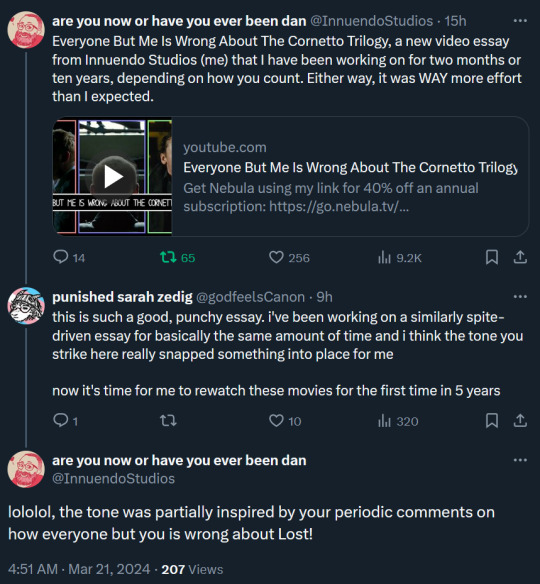
well i guess i'd better hurry up and make this fucking LOST video, huh?
<- ROUNDUP #4 | ROUNDUP #6 ->
#vidrev#video essay#video essay review#video recommendation#caleb gamman#yellow paint#jeffiot#innuendo studios#ian danskin#brother burn#blue bidya game#oliver lugg#fingerboard#half life#mass extinction#cornetto trilogy#Youtube
3 notes
·
View notes
Text
🗡🏆 HUNGER GAMES SIMULATOR 🏆🗡
INTRO
Because of the posts by @maddgical-boy [link] & @nevermore-grimes [link], I will now be subjecting my paras to the Horrors. I have a lloottttt of paras, so to make this simply I used a random number generator to select the new victims tributes.
I will also be adding commentary on how accurate this would be to my paras. Because I can’t have fun without criticizing their every decision, despite forcing them to make those decisions in the first place. Bullying my paras is a full time job and brother, I just clocked in >:3
TRIBUTES
District 1: Edward Nixon [Mad as a Crow: Missing Piece of the Puzzle], Lucy Fisher [Phantasmagoria: DreamSet Circus]
District 2: Loyd Nixon [Mad as a Crow: Missing Piece of the Puzzle], Benjamin Graves [Mad as a Crow]
District 3: Marzipan Velveteen [Fractured Fables: Illusions of Life], Neil O’Brian [Mad as a Crow: A Plague of Octopuses]
District 4: Beelzebub Honeyblood [Phantasmagoria: Crossfire], Reign Blanc [Fractured Fables: Illusions of Life]
District 5: Phineas Glazier [Fractured Fables: Illusions of Life], Luciana Potenza [Phantasmagoria]
District 6: Phoebe Sparks [Phantasmagoria: ElectroGear Software], Prism Raymond [Phantasmagoria: DreamSet Circus]
District 7: Thackery Velveteen [Phantasmagoria: Illusions of Life], Rosemary Velveteen [Fractured Fables: She Trusts me, He Loves Me Not]
District 8: Victor West [Mad as a Crow], CaterpillarOS [Fractured Fables: Illusions of Life]
District 9: Mary Crowley [Mad as a Crow], Ketrill Hyde [Phantasmagoria: As the World Falls Down]
District 10: Khole Banner [Mad as a Crow: Assembled Monsters], Alex Grimm [Fractured Fables]
District 11: Stacy Collins [Mad as a Crow], Orion Guerrero [Mad as a Crow]
District 12: Vincent Hyde [Phantasmagoria], Lucien Jekyll [Phantasmagoria]
BLOODBATH

Yknow what i just realized. CaterpillarOS is, uh, a giant robot caterpillar. Khole is a weird mix of species but yeah there’s no way he’d win that fight.
Aint no fucking way Neil would loose to a blind girl. She has the power of accuracy but is smaller and younger than Neil. He’d rip her to shreds!!
HOW DID PHINEAS SET KETRILL ON FIRE LMAO
DAY 01
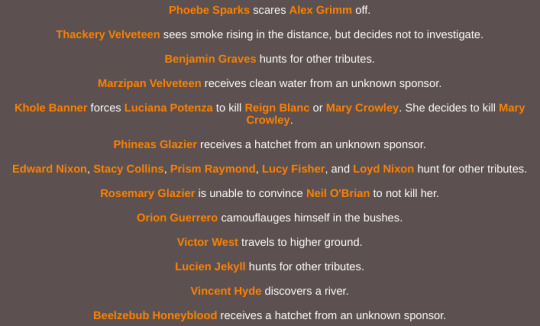
I like to think she read him, ironically, one of the brother’s grimms books. It’d be so funny for various reasons.
NNOOO MARY 😭 say goodbye to our only licensed nurse everyone…
uuuuhhh something something phineas in the wrong paracosm. insert joke about d//c or para!jervis here.
Interesting team up! No idea why Eddie would work with Loyd since that’s his father and they hate each other. Same with Stacy, she hates Eddie bc that’s her dad. I fully believe Prism and Lucy are being held captive here, folks.
Accurate !!! sorry rosemary BUT ALSO. WOW. I CANNOT OVERSTATE HOW ACCURATE THIS IS OH MY GOD??? GIRL HOW DID YOU LIVE OUT YOUR TALE ALL THE WAY OUT HERE IM SCREAMING. also wow accurate for Neil too. Killing another innocent child, I see. At least this one’s intentional!
Our fallen tributes are: CaterpillarOS, Ketrill Hyde, Mary Crowley, Rosemary Glazier.
NIGHT 01
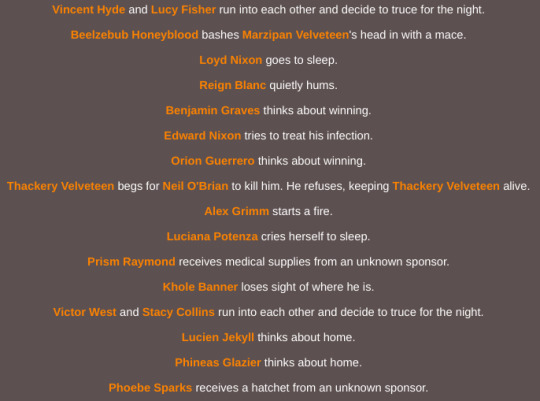
Bee! Don’t kill the bunny!! But fair lol
Debating on if Neil would keep a victim alive. I think for a little bit, for the psychological torment. He always liked to play with his food.
That is a VERY tense truce lmao, Stacy hates basically everyone Eddie is associated with, which includes the Crowley Family bc ooo boy, that family is a Certified Mess.
Luce 🤝 Phineas: ripped away from their home at a young age thanks to a random dimension portal. Not the same case here but wow I never noticed that.
DAY 02
Nothing interesting to note.
Our fallen tributes are: Marzipan Velveteen, Phineas Glazier
NIGHT 02
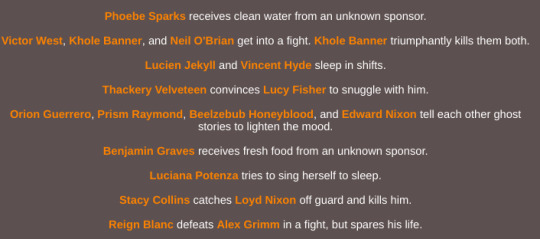
Khole winning is just…perfect. All 3 have to do with experimentation (Khole & Neil are from the same lab/facility/organization, actually!) but Khole was made first, both in a story context and meta context. So. yeah. Older Sibling Rights.
TWIN TEAM UP HELL YEAH!!!!
Either Orion or Eddie is winning those ghost stories bc Orion knew Aurelia, and she worshiped the god of fear, while Eddie knows Jonathan, Aurelia’s descendant and uses fear in his villain schemes. Then again, Bee is literally a demon, so….
YAY STACY!!! sorry loyd just…sucks lmao fuck outta here
DAY 03
Nothing interesting to note.
ARENA EVENT
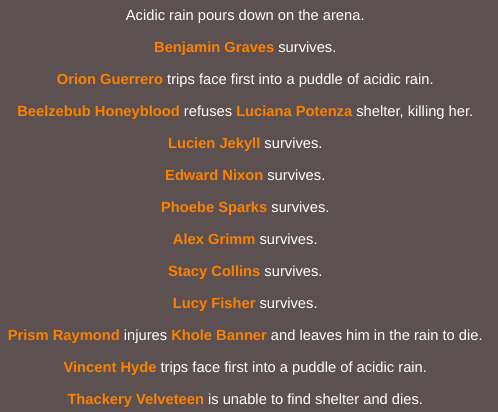
Our fallen tributes are: Victor West, Neil O’Brian, Loyd Nixon, Reign Blanc, Orion Guerrero, Luciana Potenza, Khole Banner, Vincent Hyde, Thackery Velveteen. Only 9 people left!
Nothing of interest to note for NIGHT 03.
THE FEAST happens, aka The Cornucopia is refilled.
Nothing interesting to note for DAY 04 & NIGHT 04.
Our fallen tributes are: Benjamin Graves, Lucien Jekyll.
Nothing interesting to note for DAY 05 & NIGHT 05.
DAY 06: Eddie dies by accidentally drinking his own poison. Get wrecked, idiot.
NIGHT 06: Prism bashes Alex’s head in. Get his ass!!
Nothing interesting to note for DAY 07, NIGHT 07, & DAY 08.
NIGHT 08: Stacy poisons Prism. Lucy dies from thirst.
Stacy wins!! Wow. Fucking lame as shit I don’t even like her. Wish she stayed wherever the fuck she was before moving to Prism Pulse. Whatever! Realistically speaking she would’ve been killed way back at that random family reunion thing. Yes, by Eddie. he would’ve killed his own daughter. what of it.
#paraportal#luka.txt#dlc: hunger games#system: eternal labyrinth#console: phantasmagoria#console: mad as a crow#console: fractured fables#sorry i kinda lost steam / got bored lmaoaoo#it is funny to me that they only lasted 8 days. like yeah. that checks out.
6 notes
·
View notes
Text
Looknook?

1
Female body sex
5'8" height
120-144lb weight
Hypercompetence (Writing, Cartooning, Multimedia Explainers & other creativity… )
Photographic Memory
Polyglot (French, English, German, Shoshoni, Assyrian, Hungarian, Samoan, Korean, Huron, Swahili, Basque, Celestials, Infernals...)
Past Revision for Balanced Education & Career Success (University graduate in History, Philosophy, Linguistics & Socio-Economics with VLSI & data science viz expertise, financially + socially abundant with leisure, free time and a overall empowering career)
Easing-out some my Autism Spectrum Disorder
Toolkit of Lisp tools and utilities
Amber Earmuffs
Black Matte Lipstick, Nailpaint & Eyeliner
Custom face masks
Cloven Hoof Shoes
My own Etsy + Pinterest profiles'-inspired personal wardrobe
Habitable minivan
Soft warm cozy retrofuturistic large home & vast domain
Abundant, powerful and freed-from-blockages mind
Grounded, handsome and comfortable lifestyle
Interesting, fulfilling & happy there-after life
Overall "Solar Dark Oxymoron" aesthetic
Manifestation tutor & social assistance synthetic-tier android blonde girlfriend in Ava.
Black Angora Housecat & Magick Familiar as Shoshona.
Chronokinesis & Retrocognition superpowers
True Polymorph superpower
480-600 years as extended lifespan
Historical & political key role(s) in long-term history
Self-Hosting Personal Web net-server with Quakeworld instance and a bunch more... services.
Brand new aesthetic yet FSF-compliant computer build with a Nvidia RTX 4090-tier GPU & AMD 7900X3D-tier RISC-V CPU
IBM Z/16-tier LinuxOne mainframe for simulative and business-related purposes (OpenPOWER hardware & AIX-tier GLOSS HyperVisor LinuxOne?)
LTO Tape Storage & other data processing + storage industrial facilities for historical archival and long-term preservation;
Any decent Symbolics Lisp Machine whatsoever
DEC Alpha hardware & software
SPARC Voyager
SEGA Dreamcast (Gen1) bundle
DECmate III with its dedicated disk drive unit
Sinclair QL
Xerox Daybreak
R2E Micral Portal
My very own public computation history living museum & library archives
RISC-V SBCs
RC2014 Zed Pro
Intersil 6100 & 6120 CPUs & other 12-bit support chips
Apple iMac M3-Max CPU+GPU, 24 GB RAM, 2TB baseline storage + 2TB additional storage drive, Magic Mouse + Trackpad & relevant accessories (to port Asahi Linux & more open source stuff towards…);
7 notes
·
View notes